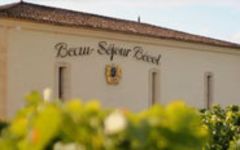Chateau Beau-Sejour Becot 2003
-
Robert
Parker -
Wine
Enthusiast -
Wine
Spectator


Product Details
Your Rating
Somm Note
Winemaker Notes
Professional Ratings
-
Robert Parker's Wine Advocate
From a 41-acre vineyard situated on St.-Emilion’s limestone plateau, Beau-Sejour-Becot’s blend can vary, but it is approximately 70% Merlot, 24% Cabernet Franc, and 6% Cabernet Sauvignon. Production can be as low as 4,000+ cases (in a tiny vintage such as 2003), or as high as 7,000+ cases (in an abundant year such as 2004). The 2003, which reminds me of a 1990 Right Bank Bordeaux, tips the scales at 13.5% alcohol. Its dark plum/ruby/purple color is followed by a sweet nose of creosote, scorched earth, black cherries, currants, and pain grille. Deep, full-flavored, muscular, textured, and rich with light to moderate tannin in the finish, this lavishly rich, full-bodied effort requires 1-3 years of bottle age, and should drink well over the following 12-15.
-
Wine Enthusiast
An exotic, smoky, tarry wine which has great ripe tannins and subtle flavors of new wood. It is smooth, polished but with the promise of power.
Barrel Sample: 89-91 -
Wine Spectator
Opulent aromas of ripe fruit, toasted oak and grilled meat. Full-bodied, with velvety tannins and loads of fruit and lightly toasted oak. Very long and delicious. Balanced wine. Best after 2010. 4,665 cases made.
Other Vintages
2022- Vinous
-
Robert
Parker -
Jeb
Dunnuck - Decanter
- Vinous
-
Robert
Parker -
Jeb
Dunnuck -
James
Suckling
-
James
Suckling - Vinous
- Decanter
-
Robert
Parker -
Jeb
Dunnuck -
Wine
Spectator
- Decanter
-
James
Suckling -
Wine
Spectator -
Robert
Parker
-
Wine
Enthusiast -
James
Suckling -
Jeb
Dunnuck -
Wine
Spectator -
Robert
Parker - Decanter
-
Robert
Parker -
Wine
Enthusiast -
Wine
Spectator -
James
Suckling - Decanter
-
Jeb
Dunnuck
-
Robert
Parker -
Wine
Enthusiast -
Jeb
Dunnuck -
James
Suckling - Decanter
-
Wine
Spectator -
Connoisseurs'
Guide
-
Wine
Enthusiast -
James
Suckling -
Wine
Spectator -
Robert
Parker - Decanter
-
Wilfred
Wong -
Wine
Enthusiast -
Wine
Spectator -
Robert
Parker -
James
Suckling
-
Wine
Enthusiast -
Wine
Spectator -
Robert
Parker - Decanter
-
Wine
Enthusiast -
Wine
Spectator -
James
Suckling -
Robert
Parker
-
James
Suckling -
Wine
Enthusiast -
Wine
Spectator -
Robert
Parker
-
Wine
Enthusiast -
Robert
Parker -
Wine
Spectator
-
Jeb
Dunnuck -
Robert
Parker -
Connoisseurs'
Guide -
Wine
Spectator -
Wine &
Spirits
-
Wine
Spectator -
Robert
Parker -
Wine &
Spirits
-
Jeb
Dunnuck -
Robert
Parker
-
Wine &
Spirits -
Robert
Parker


The estate was named Beau-Séjour in 1787 by General Jacques de Carle, the proprietor at the time. Michel Bécot bought the estate from Doctor Jean Fagouet in 1969 and further increased the area under vine from 10.5 hectares to 15 by acquiring 4.5 hectares on the Trois Moulins plateau in 1979. The chateau then took on the name of Beau-Séjour Bécot. The vines are planted on perfectly homogenous soil ideal for producing fine wine. Michel Bécot retired in 1985. His two sons, Gérard and Dominique, now manage the estate.

One of the world’s most classic and popular styles of red wine, Bordeaux-inspired blends have spread from their homeland in France to nearly every corner of the New World. Typically based on either Cabernet Sauvignon or Merlot and supported by Cabernet Franc, Malbec and Petit Verdot, the best of these are densely hued, fragrant, full of fruit and boast a structure that begs for cellar time. Somm Secret—Blends from Bordeaux are generally earthier compared to those from the New World, which tend to be fruit-dominant.

Marked by its historic fortified village—perhaps the prettiest in all of Bordeaux, the St-Émilion appellation, along with its neighboring village of Pomerol, are leaders in quality on the Right Bank of Bordeaux. These Merlot-dominant red wines (complemented by various amounts of Cabernet Franc and/or Cabernet Sauvignon) remain some of the most admired and collected wines of the world.
St-Émilion has the longest history in wine production in Bordeaux—longer than the Left Bank—dating back to an 8th century monk named Saint Émilion who became a hermit in one of the many limestone caves scattered throughout the area.
Today St-Émilion is made up of hundreds of independent farmers dedicated to the same thing: growing Merlot and Cabernet Franc (and tiny amounts of Cabernet Sauvignon). While always roughly the same blend, the wines of St-Émilion vary considerably depending on the soil upon which they are grown—and the soils do vary considerably throughout the region.
The chateaux with the highest classification (Premier Grand Cru Classés) are on gravel-rich soils or steep, clay-limestone hillsides. There are only four given the highest rank, called Premier Grand Cru Classés A (Chateau Cheval Blanc, Ausone, Angélus, Pavie) and 14 are Premier Grand Cru Classés B. Much of the rest of the vineyards in the appellation are on flatter land where the soils are a mix of gravel, sand and alluvial matter.
Great wines from St-Émilion will be deep in color, and might have characteristics of blackberry liqueur, black raspberry, licorice, chocolate, grilled meat, earth or truffles. They will be bold, layered and lush.
